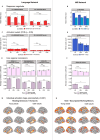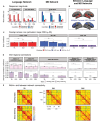This is a preprint.
The language network ages well: Preserved selectivity, lateralization, and within-network functional synchronization in older brains
- PMID: 39484368
- PMCID: PMC11527140
- DOI: 10.1101/2024.10.23.619954
The language network ages well: Preserved selectivity, lateralization, and within-network functional synchronization in older brains
Abstract
Healthy aging is associated with structural and functional brain changes. However, cognitive abilities differ from one another in how they change with age: whereas executive functions, like working memory, show age-related decline, aspects of linguistic processing remain relatively preserved (Hartshorne et al., 2015). This heterogeneity of the cognitive-behavioral landscape in aging predicts differences among brain networks in whether and how they should change with age. To evaluate this prediction, we used individual-subject fMRI analyses ('precision fMRI') to examine the language-selective network (Fedorenko et al., 2024) and the Multiple Demand (MD) network, which supports executive functions (Duncan et al., 2020), in older adults (n=77) relative to young controls (n=470). In line with past claims, relative to young adults, the MD network of older adults shows weaker and less spatially extensive activations during an executive function task and reduced within-network functional synchronization. However, in stark contrast to the MD network, we find remarkable preservation of the language network in older adults. Their language network responds to language as strongly and selectively as in younger adults, and is similarly lateralized and internally synchronized. In other words, the language network of older adults looks indistinguishable from that of younger adults. Our findings align with behavioral preservation of language skills in aging and suggest that some networks remain young-like, at least on standard measures of function and connectivity.
Keywords: aging; functional connectivity; functional localization; language network; lateralization; multiple demand network.
Conflict of interest statement
Competing Interest Statement: Dr. Kiran is a scientific advisor for Constant Therapy Health, but there is no overlap between this role and the submitted investigation. The other authors report no conflicts.
Figures



Similar articles
-
A robust dissociation among the language, multiple demand, and default mode networks: Evidence from inter-region correlations in effect size.Neuropsychologia. 2018 Oct;119:501-511. doi: 10.1016/j.neuropsychologia.2018.09.011. Epub 2018 Sep 20. Neuropsychologia. 2018. PMID: 30243926 Free PMC article.
-
Individual Variability in Performance Reflects Selectivity of the Multiple Demand Network among Children and Adults.J Neurosci. 2023 Mar 15;43(11):1940-1951. doi: 10.1523/JNEUROSCI.1460-22.2023. Epub 2023 Feb 7. J Neurosci. 2023. PMID: 36750368 Free PMC article.
-
The Domain-General Multiple Demand (MD) Network Does Not Support Core Aspects of Language Comprehension: A Large-Scale fMRI Investigation.J Neurosci. 2020 Jun 3;40(23):4536-4550. doi: 10.1523/JNEUROSCI.2036-19.2020. Epub 2020 Apr 21. J Neurosci. 2020. PMID: 32317387 Free PMC article.
-
Healthy aging by staying selectively connected: a mini-review.Gerontology. 2014;60(1):3-9. doi: 10.1159/000354376. Epub 2013 Sep 28. Gerontology. 2014. PMID: 24080587 Review.
-
Understanding cognitive control in aging: A brain network perspective.Front Aging Neurosci. 2022 Oct 31;14:1038756. doi: 10.3389/fnagi.2022.1038756. eCollection 2022. Front Aging Neurosci. 2022. PMID: 36389081 Free PMC article. Review.
References
Publication types
Grants and funding
LinkOut - more resources
Full Text Sources
Miscellaneous
